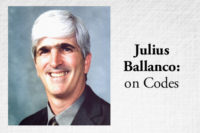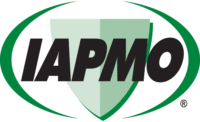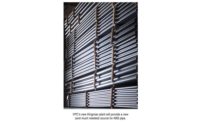One of the final steps in the IAPMO consensus process for developing the Uniform Plumbing Code is the appeals before the Standards Council.
The overall control of the code is in the hands of the council. While the council doesn’t deal directly with every technical issue, it is up to the group to approve the code once the technical review has been completed.
Because IAPMO allows a membership vote at its annual meeting, the decisions of the consensus Technical Committee can be overturned. This occurred on a number of issues during the 2015 cycle. If the Technical Committee vote does not support the membership vote, the code change is appealed. Simply stated, the Standards Council deals with the real controversial issues.
Three appeals to the Uniform Plumbing Code were of particular interest. The first dealt with the location of an ASSE 1070 thermostatic mixing valve. If you review ASSE 1070, you will find a confused standard. I have always been of the opinion that the standard isn’t sure what it wants to do – control temperature or limit the high temperature. Is the standard for point-of-use products such as faucets or centrally located valves? Of course, most involved with the development of the standard will say it is all those things. Now you see where the application of the standard creates a problem in the plumbing code.
Furthermore, if the standard is to limit the maximum temperature, what should that high temperature be? Should the standard or the plumbing code set the high temperature? Should the maximum temperature be controlled in the field or factory set?
Getting back to the appeal, IAPMO membership voted to require all mandated ASSE 1070 devices to be at the point of use. With language such as this in the code, it could be interpreted in a number of ways. If there are 10 lavatories in a women’s restroom, does each lavatory require an ASSE 1070 device or can one device serve all 10 lavatories? Or should each faucet for the lavatory be listed as conforming to ASSE 1070? You see, even a faucet can be listed to the standard. It doesn’t require a separate valve.
The next question is: why isn’t a centrally located ASSE 1070 adequate? If the device is both thermostatically controlling the hot water and preventing high-temperature water from being discharged, doesn’t a central valve do the same as a locally installed valve?
ASPE filed a letter in support of the Technical Committee position, which was to not require ASSE 1070 valves to be installed at the fixture. Thus, an engineer could choose a point-of-use application or a central application of the valve.
This position was emphasized during the appeal. The Standards Council was encouraged to support the position of the Technical Committee, but no one appeared at the hearing to support the membership position.
The Standards Council supported the position of the Technical Committee and rejected the membership vote. It effectively returned the code section back to the language that was published in the 2012 edition. This was a victory for the plumbing engineering community.
Up in the air
The next appeal dealt with trap seal protection. A code change approved by the Technical Committee added the three standards for protecting a trap seal of a floor drain – ASSE 1018, ASSE 1044 and ASSE 1072. The IAPMO membership voted to reject the change, voicing concern about ASSE 1072. The issues were not technically based and more of a knee-jerk reaction to a new product thought to be too easy to install. Keep in mind there are about seven manufacturers of ASSE 1072 devices. These barrier protective devices have become the most popular way to protect a floor drain trap seal.
There was discussion both for and against this change at the appeal. In the end, the Standards Council removed all three standards from the code section in the 2015 Uniform Plumbing Code. The group reverted the code language back to the text found in the 2012 code.
Shortly after this decision, union representatives filed a request for a temporary interim amendment or TIA. This is an emergency measure for adding something to the code. The union reps want to add ASSE 1018 and ASSE 1044 to the code section and they purposely excluded ASSE 1072. While that TIA vote is ongoing, to date it has not received the number of required votes to be accepted.
Where is the line?
The third appeal of note involved cast-iron soil pipe. The Cast Iron Soil Pipe Institute proposed a change to recognize Annex A of ASTM A888 for third-party certification cast-iron soil pipe. The code change seemed rather straight forward and non-controversial. It had received the support of the Plumbing Technical Committee. However, the Standards Council ruled the change overstepped the bounds of the Technical Committee and Plumbing Code. In other words, the code cannot regulate cast iron to the details that CISPI is proposing. It also is saying that Annex A cannot be mandated in the plumbing code.
This raises a serious issue that all plumbing codes will need to address. How much of a standard is enforceable?
Annex A of ASTM A888 states it is a mandatory annex, but it is an annex. The requirements are not found in the body of the standard. Many standards are written this way and they have annexes or appendices. The annexes or appendices are listed as normative, mandatory, informative or nonmandatory. In standard language normative means mandatory and, similarly, informative means nonmandatory.
So, if an annex or appendix are normative or mandatory do the requirements apply when the standard is referenced as a mandatory standard in the Plumbing Code? That is the question that must be answered.
Most in the profession already have interpreted mandatory annexes or appendices as being required by the plumbing code. If this is the case, Annex A of ASTM A888 would already be applicable in the Uniform Plumbing Code.
The Standards Council maintained its position that the reference to Annex A should not appear in the Uniform Plumbing Code. Following the Standard Council’s decision, this change was further appealed to the IAPMO Board of Directors. Hence, the final outcome of this code requirement will be in the hands of the IAPMO board. Board decisions typically are based on procedures and not on technical merit.
Whatever the board decides will impact how the Uniform Plumbing Code applies mandatory annexes and appendices. The appeal will be heard this month with the results published shortly thereafter.
The 2015 IAPMO Uniform Plumbing Code will be published once all the appeals are completed.
HELPFUL LINKS:




